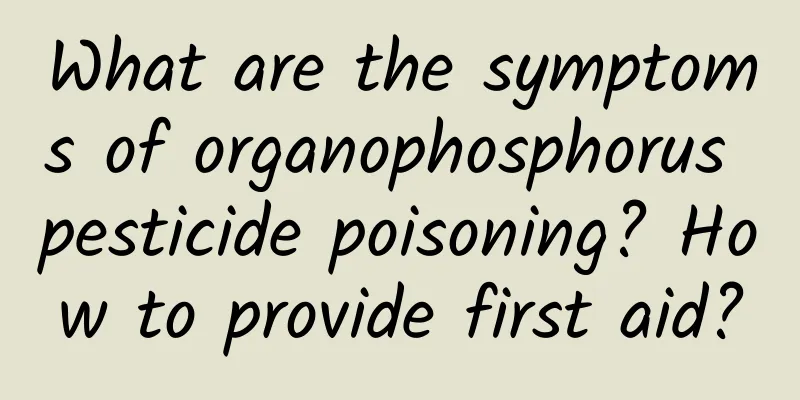What are the symptoms of organophosphorus pesticide poisoning? How to provide first aid?

|
Author: Qiu Zewu, Chief Physician of the Fifth Medical Center of the General Hospital of the Chinese People's Liberation Army Reviewer: Wang Lixiang, Chief Physician, Third Medical Center, PLA General Hospital The 10th Chairman of the Science Popularization Branch of the Chinese Medical Association Organophosphorus pesticides are one of the most widely used and largest-volume insecticides in the world. Common organophosphorus pesticides such as methamidophos, phorate, dichlorvos, omethoate, chlorpyrifos, phoxim, etc. have a high incidence of human poisoning. Organophosphorus pesticide poisoning refers to the symptoms mainly caused by damage to the neuromuscular system when a large amount of organophosphorus pesticides enter the human body in a short period of time. The poisoning mechanism of organophosphorus pesticides is to inhibit acetylcholinesterase in the body, so that the poison cannot be decomposed into acetylcholine, resulting in a large amount of acetylcholine accumulation in the neuromuscular junction, thus producing a series of symptoms. The severity of the symptoms depends on the severity of the poisoning. Mild poisoning is mainly manifested by digestive symptoms such as nausea, vomiting, and abdominal pain; pupil constriction and blurred vision; in addition, symptoms such as dizziness and fatigue may also occur. Moderate poisoning appears on the basis of the manifestations of mild poisoning. First, the secretion increases, and a large amount of secretions flow out of the nasal cavity and oral cavity; second, muscle weakness, muscle tremors, and muscle paralysis. Figure 1 Original copyright image, no permission to reprint On this basis, if symptoms such as respiratory failure, circulatory failure, impaired consciousness, or even shock occur, it is considered to be severe poisoning. The above is the classification of the severity of organophosphorus pesticide poisoning based on symptoms. Generally speaking, classification by symptoms is the most reliable. Of course, there is also a detection method, which is to detect the activity of cholinesterase. Generally, if the activity of cholinesterase is less than 30% of the normal value, it is considered severe poisoning; if it is between 30% and 50% of the normal value, it is considered moderate poisoning; if it is between 50% and 70% of the normal value, it is considered mild poisoning; if it is greater than 70% of the normal value, organophosphorus pesticide poisoning is basically not considered. This is to judge the degree of poisoning of organophosphorus pesticides based on the activity of cholinesterase. So, what should you do first when you find a patient with organophosphorus pesticide poisoning? If it is an orally administered organophosphorus pesticide, before being sent to the hospital or before arriving at the hospital, the patient is conscious. First, use your middle finger to pick the root of the patient's tongue, or press the root of the patient's tongue with chopsticks to induce vomiting, so that he can vomit out the poison in his stomach. There is a time limit for inducing vomiting. If the poison has been in the body for more than 6 hours, most of it has been absorbed, and the effect of inducing vomiting will be greatly reduced. For example, if you see someone who has just taken organophosphorus pesticides, induce vomiting immediately and call 120. Second, after inducing vomiting for the first time, the patient should drink an appropriate amount of water (about 300-500 ml) to mix the residual pesticides in the stomach with the water evenly, then induce vomiting again, and repeat this process several times. During the entire vomiting process, ensure that the patient remains awake and controls the amount of water they drink to prevent aspiration pneumonia. If the patient has fallen into a coma, do not try to induce vomiting. At this time, seek professional medical assistance immediately to avoid serious consequences due to delayed treatment. If the patient is sent to the hospital by family members or rescuers, be sure to keep the patient in a side-lying position during transportation to prevent vomitus from blocking the respiratory tract and causing suffocation. Figure 2 Original copyright image, no permission to reprint After the organophosphorus pesticide poisoning patient is sent to the hospital, the doctor will decide whether to perform tracheal intubation or gastric lavage first according to the patient's condition. Tracheal intubation should be performed first and then gastric lavage. If gastric lavage is performed first and then tracheal intubation, respiratory and cardiac arrest, vomiting and suffocation may occur during gastric lavage, and there will be no time for rescue, leading to death. Therefore, whether to perform tracheal intubation or gastric lavage first is more important and needs to be judged by professional doctors. Second, using effective anti-toxic drugs as early as possible will increase the chances of recovery. Common anti-toxic drugs include atropine (an anticholinergic drug), which is a drug that fights symptoms; drugs that cure the root cause, drugs that restore cholinesterase activity, that is, cholinesterase reactivators, such as pralidoxime chloride. Most patients can achieve good outcomes when these two drugs are used in combination, in a timely and sufficient manner. Whether patients with organophosphorus pesticide poisoning need repeated gastric lavage depends mainly on the poisoning dose and the severity of the disease. Generally speaking, patients with severe poisoning need repeated gastric lavage. First, there is no guarantee that one gastric lavage can be completely cleaned; second, toxicological experiments have shown that after gastric lavage, it is found that there are still residual poisons in the folds of the gastric mucosa; third, most organophosphorus pesticides are fat-soluble poisons. After fat-soluble poisons enter the body, the body will transport these poisons to fat for storage, and then with food, the poisons can be discharged from the bile duct. How do doctors determine whether the poison has been completely eliminated? First, check whether the gastric lavage fluid is clear and has no odor. Severe patients need to have a gastric tube inserted and gastric fluid is extracted for observation every 3-5 hours. Second, do a toxicology test to see if there are still poisons in the gastric fluid. Third, observe the reaction after treatment and whether the condition is stable after drug treatment. If the condition is stable and there is no progression, the gastric fluid has no odor, and the toxicology test is normal, it is generally considered that the gastric lavage is clean. After being discharged from the hospital, patients with organophosphorus pesticide poisoning can go home for proper rest and live and work normally, and generally there will be no problems. Patients with severe poisoning or poisoning by special poisons may experience some sequelae, such as numbness and pain in the limbs after returning home for a period of time; inability to touch the ground with both feet; weakness when walking, muscle weakness; atrophy of thenar muscles; walking like a rooster, and unable to lift the feet off the ground. At this time, it is necessary to consider whether delayed peripheral neuropathy has occurred. Although the probability of occurrence is relatively low, it may also occur, and timely medical treatment is required. |
<<: Can rodenticide poisoning lead to death? Is there any specific drug treatment?
Recommend
Can medication abort a child?
article...
I have a strong menstrual period but I am pregnant
When women reach a certain age, they will have th...
Second month of pregnancy
What are the things that pregnant women should pa...
Nipple changes during early pregnancy
Many people who have been pregnant know that brea...
Is laparoscopic surgery for cystic cyst painful?
The laparoscopic procedure for chocolate cysts is...
What to do if pregnant women have itching and pain below
Many women are very worried about their physical ...
What foods are good for your ovaries?
Female friends all hope that they will always loo...
Common knowledge and significance of female sex hormone measurement
The content of sex hormones varies at different s...
Stretch marks on breasts during pregnancy
Stretch marks are a type of lines that pregnant w...
What to do if you have mastitis during pregnancy
After pregnancy, if a pregnant woman is diagnosed...
What are the symptoms of postmenopausal women?
Most female friends gradually stop menstruating a...
Is your sleep "junk sleep"? It is said to be more terrible than insomnia...
This article was reviewed by Zhao Wei, MD, associ...
Causes of urethral bleeding in pregnant women
Pregnant women should never do strenuous exercise...









